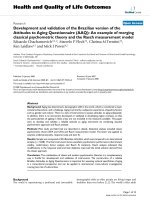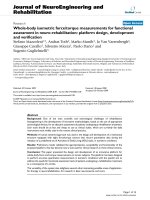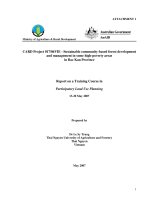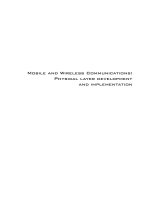Week 1 theory development and verification
Bạn đang xem bản rút gọn của tài liệu. Xem và tải ngay bản đầy đủ của tài liệu tại đây (921.28 KB, 11 trang )
3/15/2012
1
THEORY DEVELOPMENT
AND VERIFICATION
Week 1 – ACC304
CHAPTER 1
INTRODUCTION
GODFREY
HODGSON
HOLMES
TARCA
Overview of Accounting Theory
What is a theory?
Hendriksen’s definition:
…the coherent set of hypothetical, conceptual and
pragmatic principles forming the general framework of
reference for a field of inquiry.
3
What is an accounting theory?
Hendriksen’s definition:
…logical reasoning in the form of a set of broad principles
that
provide a general framework of reference by
which accounting practice can be evaluated and
guide the development of new practices and
procedures.
4
Overview of Accounting Theory
Overview of Accounting Theory
Whether a theory is accepted depends on how:
well it explains and predicts reality
well it is constructed both theoretically and empirically
acceptable its implications are
5
Overview of Accounting Theory
Accounting theory is a modern concept compared
to mathematics or physics
Even Pacioli’s treatise on double-entry accounting
1495) focused on documenting practice and did
not explain the underlying theoretical basis for it
6
3/15/2012
2
Overview of Accounting Theory
The development of accounting
theory has been mostly unstructured
Chambers:
Accounting has frequently been described as a body of
practices which have been developed in response to
practical needs rather than by deliberate and systematic
thinking.
7
Overview of Accounting Theory
8
Was developed to resolve problems as they arose
– reactive
Ad hoc approach
Led to inconsistencies in practice
e.g. different depreciation methods
Accounting standard setting
Conceptual framework projects have not resolved
inconsistency in practice
Pre-theory (1400s – 1800)
Goldberg:
No theory of accounting was devised from the time of
Pacioli down to the opening of the nineteenth century.
9
Pragmatic accounting (1800– 1955)
The ‘general scientific period’
based on empirical observation of practice
provided an explanation of accounting practice
focused on the existing ‘viewpoint’ of accounting
10
Normative accounting (1956-1970)
Sought to establish ‘norms’ for the best accounting
practice
Focused on what should be (the ideal) v. what is
11
Normative accounting (1956-1970)
Degenerated into battles between competing
viewpoints on measuring and reporting accounting
information
Two groups dominated:
conceptual framework proponents
critics of historical cost
12
3/15/2012
3
Normative accounting (1956-1970)
Factors prompting the demise of the normative
period include:
the unlikelihood of one particular normative theory
being generally accepted
the application of financial economic principles
the availability of empirical data and new testing
methods
13
Normative accounting (1956-1970)
The major criticisms of normative theories were:
they do not necessarily involve empirical hypothesis
testing
they are based on value judgements
14
Positive accounting (1950 to the present
day)
A shift to a new form of empiricism called ‘positive
theory’
Had its origins in the ‘general scientific period’
It seeks to explain the accounting practices being
observed
15
Positive accounting (1950 to the
present day)
Its objective is to explain and predict accounting
practice
e.g. the bonus plan hypothesis
16
Positive accounting (1950 to the
present day)
It helps predict the reactions of ‘players’, such as
shareholders, to the actions of managers and to
reported accounting information
17
Positive accounting (1950 to the
present day)
Major deficiencies are:
‘wealth maximisation’ has become the answer to
explain all accounting practices and reported
information
it relies excessively on agency theory and dubious
assumptions about the efficiency of markets
18
3/15/2012
4
Positive accounting (1950 to the present
day)
Behavioural research:
concerned with the sociological implications of
accounting numbers and the associated actions of ‘key
players’
emerged in the 1950s
despite growing acceptance since the 1980s, positive
accounting theory still dominates
19
Recent developments
Academic and professional developments in
accounting theory have tended to take different
approaches
Academic research focuses on capital markets,
agency theory and behavioural aspects
The profession has sought a more normative
approach – what accounting practices should be
adopted
20
Recent developments
21
Recent developments
Conceptual framework – resurrected in 1980s
states the nature and purpose of financial reporting
Establishes criteria for deciding between alternative
accounting practices
SACs 1–4
22
Recent developments
Conceptual framework – Recent Developments
Joint project between IASB & FASB
International harmonisation of accounting practices
through a single consistent set of international financial
reporting standards (IFRS)
23
Recent developments
The conceptual framework underpinning the IFRS
favours a move toward
accounting practices that provide information for
enhancing decision making by investors and others
recognising all gains and losses in the accounting
periods in which they occur
measurement using exit values
24
3/15/2012
5
Content outline
Part 1: Accounting theory (chapters 1 – 3)
Part 2: Theory contributing to practice (chapters 4 –
10)
Part 3: Accounting and research (chapters 11 – 14)
25
Summary
Accounting theory
Major periods of accounting theory development
Normative accounting
Positive accounting
Conceptual framework
IFRS
26
Key terms and concepts
Theory
Accounting theory
Normative theory
Positive theory
Behavioural theory
Conceptual framework
IFRS
27
CHAPTER 2
ACCOUNTING THEORY CONSTRUCTION
GODFREY
HODGSON
HOLMES
TARCA
Pragmatic theories
Descriptive pragmatic approach:
based on observed behaviour of accountants
theory developed from how accountants act in
certain situations
tested by observing whether accountants do act
in the way the theory suggests
is an inductive approach
29
Pragmatic theories
Criticisms of descriptive pragmatic approach:
does not consider the quality of an accountant’s action
does not provide for accounting practices to be
challenged
focuses on accountants’ behaviour not on measuring the
attributes of the firm (assets, liabilities, profit)
30
3/15/2012
6
Pragmatic theories
Psychological pragmatic approach:
theory depends on observations of the reactions
of users to the accountants’ outputs
a reaction is taken as evidence that the outputs
are useful and contain relevant information
31
Pragmatic theories
Criticisms of the psychological pragmatic approach:
some users may react in an illogical manner
some users might have a preconditioned response
some users may not react when they should
Theories are therefore tested using large samples
of people
32
Examples of pragmatic theories
(i) an historical record-keeping activity (pragmatic or
syntactic theory)
(ii) political theories (pragmatic theories)
(iii) communication — decision making (pragmatic,
syntactic and semantic theories)
(iv) accounting as an economic good (pragmatic)
(v) accounting as magic or mythology (pragmatic)
(vi) accounting as a social commodity to exploit or aid
policies or as a social club for accountants (pragmatic)
historical record-keeping activity
Example: firms use accounting principles to keep a
record of their transactions so that they can advise how
resources have been used.
a language
Example: financial statements are used by management
to communicate to shareholders how well they have
performed in running the business.
political theories
Example: management use accounting reports to
allocate resources among different divisions within the
firm, or different levels of employees.
magic or mythology
Example: Enron management used accounting techniques to
hide the losses it suffered from transactions with its special
purpose entities.
communication — decision making
Example: a local bank decided to give loans to a small
business after analysing the business’ financial position.
an economic good
Example: there are costs involved in producing financial
reports (not free). Accounting information is demanded to
make economic decisions, but there is a cost to its supply
since accounting information is a scarce commodity itself.
a social commodity
Example: government uses accounting numbers (such
as profits or research expenditure) to decide
whether to give grants to particular firms.
ideology and exploitation
Example: firms cut down jobs in their unprofitable
divisions.
3/15/2012
7
Syntactic theories
Semantic inputs are the transactions and exchanges
recorded in vouchers, journals and ledgers
The inputs are then manipulated on the basis of the
premises and assumptions of historical cost accounting
But there are no pragmatic test (how people them),
or what they mean (semantic test)
Eg: the theory of double-entry and historical costs
37
Syntactic theories
Criticised because there is no independent empirical
verification of the calculated outputs (profits, total
assets)
The outputs may be criticised for poor syntax
inaccurate e.g. different types of monetary
measures are added together
Adding up value of a machine owned 20 years ago
and value of a machine purchased yesterday
38
Disadvantages of Syntactic theories
The truth value of any proposition is ascertained by
logic or reasoning alone.
If the underlying accepted premises of the logic have
no reference to the real world or are false, then the
conclusions have either no pragmatic usefulness or the
conclusion is incorrect.
Syntactics alone are only concerned with the
derivation of statements from other given
statements.
Disadvantages of Syntactic theories
all manipulations are correct as long as the rules of
mathematical bookkeeping are applied
there are many acceptable sets of ‘equations’
no semantic verification — not descriptive of real
world objects or events.
The outputs may be syntactically accurate but
nevertheless be valueless due to a lack of semantic
accuracy (a lack of correspondence with real-world
events, transactions or values)
Syntactic theories
Historic cost accounting may produce ‘accurate’
outputs but which nevertheless have little or no
utility
That is, they are not useful for economic decision
making except to verify accounting entries
41
Semantic theories
connects symbols, words, terms or concepts with
real-world objects, events or functions and is seen to
make a theory realistic.
measurement theories:
Eg measuring the effects of inflation on assets and
liabilities and adjusting the accounts to reflect these
adjustments accounts then have semantic content
Argument: the purpose of undertaking accounting
is to impart semantic content to the numbers then
they should be verified
3/15/2012
8
Normative theories
1950s and 1960s ‘golden age’
policy recommendations
what should be
concentrated on deriving:
true income (profit)
practices that enhance decision-usefulness
based on analytic and empirical propositions
43
Financial statements should mean what they sayFinancial statements should mean what they say
Normative theories
True income:
a single measure for assets
a unique and correct profit figure
44
Normative theories
Decision usefulness:
the basic objective of accounting is to aid the decision-
making process of certain ‘users’ of accounting reports
by providing useful accounting data
45
Normative theories
The decision process
46
Accounting
system of
company X
Accounting
system of
company X
Prediction
model of
user
Prediction
model of
user
Decision
model of
user
Decision
model of
user
Positive theories
Expanded during the 1970s
Based on ‘experiences’ or ‘facts’ of the real world
Explain the reasons for current practice
Predict the role of accounting information in
decision-making
47
Positive theories
The main difference between normative and
positive theories is that
normative theories are prescriptive
positive theories are descriptive, explanatory or
predictive
48
3/15/2012
9
Which one is positive or normative?
(a) Historical cost accounting should be
replaced by a market value system.
(b) Historical cost accounting provides
information used by creditors.
(c) Historical cost accounting is used by many
managers to allocate costs in determining divisional
performance.
Different perspectives
Scientific approach:
has an inherent assumption that the world to be
researched is an objective reality
is carried out by incremental hypotheses
has an implied assumption that a good theory holds
under circumstances that are constant across firms,
industries and time
50
Procedures of Scientific approach:
Start with prior knowledge or theory constructions
Observe real world behaviour
Does not concur: a research problem to be explained
Develop a theory to explain the behaviour and develop
testable hypotheses
Follow structured procedures for data collection and
analysis
Validate the hypotheses
Make conclusions about theory
Different perspectives
Criticism of the scientific method:
large-scale statistical research tends to lump everything
together
it is conducted in environments that are often remote
from the world of or the concerns of accountants
52
Different perspectives
Naturalistic approach:
implies that there are no preconceived assumptions or
theories
focuses on firm-specific real-world problems
53
Different perspectives
Alternative ways of looking at the world:
54
CATEGORY ASSUMPTION
1. Reality as a concrete structure
2. Reality as a concrete process
3. Reality as a contextual field of information
4. Reality as a symbolic discourse
5. Reality as a social construction
6. Reality as projection of human imagination
CATEGORY ASSUMPTION
1. Reality as a concrete structure
2. Reality as a concrete process
3. Reality as a contextual field of information
4. Reality as a symbolic discourse
5. Reality as a social construction
6. Reality as projection of human imagination
3/15/2012
10
Different perspectives
For categories 1 – 3 it is more appropriate to use
the scientific approach
For categories 4-6 the naturalistic approach is more
appropriate
55
Different perspectives
56
Scientific approach applied to accounting
Misconceptions of purpose
Make scientists out of accounting practitioners
Researchers = practitioners
The desire for ‘absolute truth’
57
Scientific approach applied to
accounting
The scientific method does not claim to provide
‘truth’
It attempts to provide persuasive evidence which
may describe, explain or predict
58
Issues for auditing theory construction
Auditing is a verification process that is applied to
the accounting inputs and processes
59
Issues for auditing theory construction
60
Auditors provide an opinion on
whether the financial statements accord with the
applicable reporting framework
whether the statements give a true and fair view
3/15/2012
11
Issues for auditing theoryconstruction
The normative era of accounting coincided with a
normative approach to auditing theory
The positive era of accounting has led to a positive
approach to auditing theory
61
Summary
Many different approaches to theory formulation
in accounting
Evolution of accounting theory
positive v. normative
scientific v. naturalistic
62
Exercises
What type of theories can resolve the following issues?
(a) the behaviour of investors to the release of
accounting data
(b) the reaction of all stock prices to the release of
accounting data and why
(c) the reaction of employees in one particular firm to
the release of accounting data
(d) all accounting reports should be adjusted by
inflation before they are released
(e) what type of accounting do firms in one particular
industry use for inventory before they release their
accounting reports
Key terms and concepts
Descriptive pragmatic approach
Psychological pragmatic approach
Syntactic and semantic theories
Historical cost accounting
Normative theories
Positive theories
Scientific approach to theory
Naturalistic approach to theory
Auditing theory
64
Positive theory: historical cost
Premises are determined by observing the practice of accountants.
Criticisms: no logical analysis of accountants’ actions, does not allow
change, does not focus on measurement, circularity of logic in the
rules, outputs not verified, doublethink, conventions not subject to
falsification.
Also pragmatic positive as it is observable and descriptive of the
behaviour of accountants over a number of centuries.
Provides a system of allocating costs over different reporting
periods (accrual accounting). A point of logical contention, however,
is whether the allocation of costs is truly systematic (in a deductive
sense), because a number of the ways in which the costs are
allocated appear to be done in an ad hoc fashion without inductive
reference to events that occur in the real world of asset valuation.









